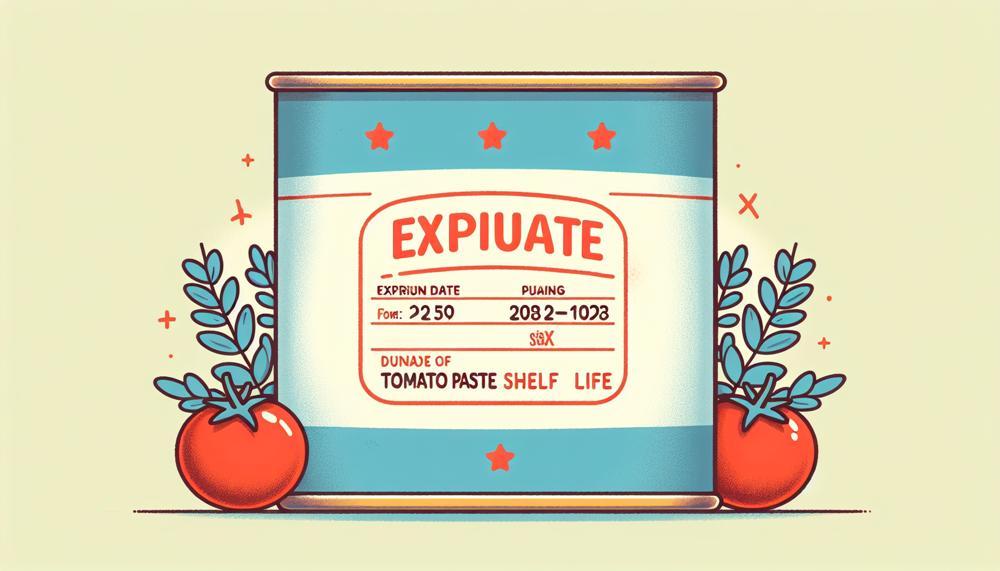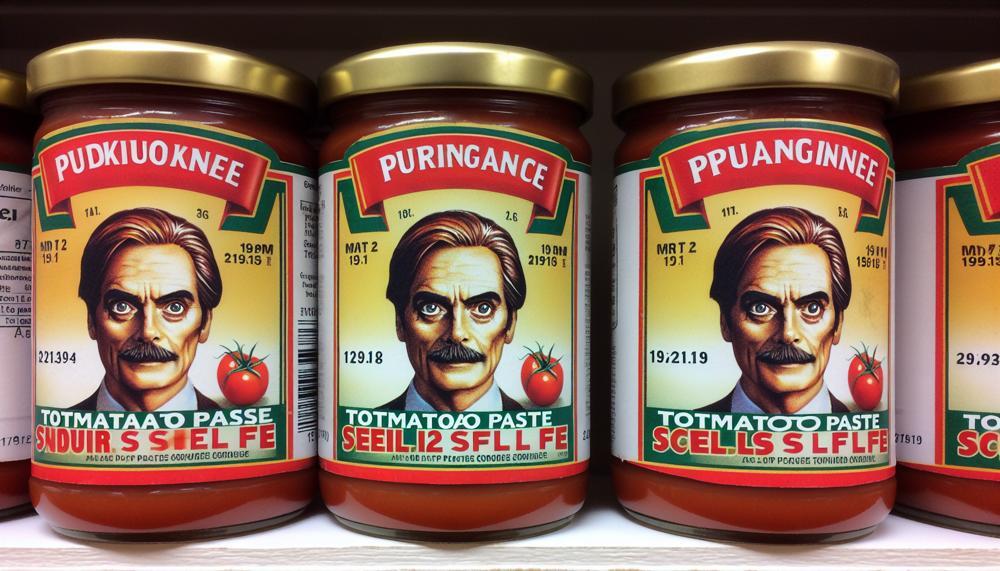Imagine this scenario: you’re in the middle of cooking a mouthwatering pasta dish and reach for your can of tomato paste, only to realize it expired months ago. We’ve all been there, but have you ever questioned the longevity of tomato paste? This pantry staple is a crucial component in many recipes, yet its expiration date often goes unnoticed.
In today’s blog post, we’ll delve into the world of tomato paste and uncover the truth about how long it really lasts. Here are some key points we’ll cover:
- The distinction between an expiration date and a best-by date
- Factors that can impact the shelf life of tomato paste
- Proper storage methods to maintain freshness
- Signs that your tomato paste has turned bad
- Creative ways to use up leftover or expired tomato paste
So, if you want to avoid ruining your next pasta night with spoiled tomato paste, keep reading.
Contents
- 1 Does Tomato Paste in a Can Go Bad?
- 2 Does Tomato Paste in a Jar Go Bad?
- 3 Does Tomato Paste in a Tube Go Bad?
- 4 How Long Does Homemade Tomato Paste Last?
- 5 Why does Tomato Paste go Bad?
- 6 How long does Tomato Paste Last After it’s been opened?
- 7 How Do I know if Tomato Paste has Gone Bad?
- 8 How to Properly Store Tomato Paste
- 9 Can You Freeze Tomato Paste?
- 10 Can You Get Sick From Eating Old Tomato Paste?
- 11 Alternatives
- 12 Conclusion
Does Tomato Paste in a Can Go Bad?
When it comes to tomato paste in a can, it typically has a shelf life of about one week after opening before it goes bad. The acidity levels in tomatoes determine the longevity of tomato paste, which can lead to spoilage if not stored correctly.
Some indications of spoiled tomato paste include slime, limpness, moisture, fuzzy mold, brown spots, or bean seed shapes coming out of the shell. It’s vital to dispose of spoiled tomato paste properly to avoid food poisoning.
To prolong the shelf life of tomato paste, it’s best to store it in the fridge. If unopened, cans of tomato paste can last up to six months past the “Best-by” date if kept in a cool place away from heat sources.
Once opened, tomato paste should be consumed within 5-7 days for optimal quality and taste. Ensuring that no air gets into the container is crucial to prevent spoilage and mold growth.
If you have excess tomato paste that you won’t be using within a week, freezing it is an option. It’s recommended to freeze tomato paste in smaller portions using ice cube trays for convenient thawing and usage.
Does Tomato Paste in a Jar Go Bad?
Yes, however, it is important to follow proper storage procedures and check for signs of spoilage before consuming.
Properly storing tomato paste in a jar is crucial. It should be kept in a cool, dry place away from direct sunlight. If unopened, it can last for 12-18 months in these conditions. Once opened, transfer it to an airtight container and store it in the fridge for maximum freshness. Freezing is also an option, but keep in mind that the quality may slightly decrease when thawed.
Before consuming canned or packaged tomato paste, be sure to inspect the packaging and contents for any signs of spoilage. These can include mold growth, slime, or limpness. If any of these are present, it is best to discard the tomato paste.
According to USDA guidelines, the recommended shelf life for high-acid canned foods like tomato paste is 12-18 months. Even if there is no expiration date on the can, always check for signs of damage or spoilage before consuming.
Storage Times:
| Unopened Tomato Paste | 12-18 months |
| Opened Tomato Paste (Refrigerated) | 5-7 days |
| Frozen Tomato Paste (Thawed) | 2-3 months |
Does Tomato Paste in a Tube Go Bad?
The answer is yes, as long as it has been stored correctly and shows no signs of spoilage. However, the taste and quality may diminish over time, so it’s best to use it within the suggested timeframe.
When placed in the refrigerator with the tube tightly sealed, opened tomato paste in a tube can last for up to six months. If the tube is unopened, it can be stored in a cool, dry place for 1-2 years. It’s important to check for any indications of spoilage, such as a change in color or unpleasant odor, before consuming.
If you’ve used only a portion of the tomato paste in the tube, it’s recommended to transfer the remaining amount to an airtight container and refrigerate it for 5-7 days. This will help preserve its freshness and prevent bacterial growth.
Another option is to freeze the tomato paste in a tube, which can extend its shelf life up to 12 months. However, once thawed, the quality and flavor may decrease. For optimal taste, it’s best to use frozen tomato paste within 3 months.
It’s worth noting that tube tomato paste is more convenient and practical compared to canned tomato paste.
The tubes allow for smaller portions without having to open an entire can, reducing waste and maintaining freshness for longer periods. However, unopened canned tomato paste does have a longer shelf life.
How Long Does Homemade Tomato Paste Last?

Tomato paste made at home typically has a shorter lifespan compared to store-bought versions. On an average, homemade tomato paste can last for about 1-2 weeks in the fridge, and up to 6 months in the freezer. However, this can vary depending on several factors such as the ingredients used, storage methods, and temperature.
Acidity Level
One of the main factors that can affect the longevity of homemade tomato paste is its acidity level.
Tomatoes are naturally acidic, which helps preserve the paste. However, if other low-acid ingredients like onions or garlic are added, it can decrease the overall acidity and shorten its shelf life.
To ensure proper acidity levels for safe preservation, it is recommended to use a tested and approved recipe.
Storage Method
Another factor that can impact the shelf life of homemade tomato paste is its storage method.
As with any food, proper storage is key to maintaining its freshness and safety. It is important to store homemade tomato paste in an airtight container or jar in the fridge to prevent bacteria growth. If opting for freezing, make sure to use freezer-safe containers or bags to avoid freezer burn.
Temperature
Lastly, temperature also plays a crucial role in determining how long homemade tomato paste will last.
Keeping it at a consistent cool temperature will help prolong its shelf life. Avoid leaving it out at room temperature for extended periods of time, as this can increase the risk of spoilage.
| Storage Method | Shelf Life | Factors Affecting Longevity |
| Pantry (unopened) | 8-12 months | – Properly sealed and stored in a cool and dry place – Consistent temperature |
| Fridge (opened) | 5-7 days | – Stored in an airtight container or original tube packaging – Consistent cool temperature |
| Fridge (tube packaging) | 1 month | – Stored in the original tube packaging – Consistent cool temperature |
| Freezer (homemade) | 6 months | – Properly sealed and stored in freezer-safe containers or bags – Consistent temperature |
Why does Tomato Paste go Bad?
Tomato paste is extremely vulnerable to spoilage for various reasons, including its high moisture levels, exposure to air and light, storage temperature, and the quality of tomatoes used.
To prevent spoilage, it is crucial to store tomato paste in an airtight container, away from light sources, and at room temperature. Alternatively, adding preservatives or freezing the paste can also assist in extending its shelf life.
The susceptibility of tomato paste to spoilage is no surprise. In fact, I once learned this the hard way when I forgot about a half-used can of tomato paste in the back of my fridge. I didn’t realize it until one day when I needed it for a recipe and found a moldy mess instead.
Ever since then, I’ve been extra careful about properly storing tomato paste to avoid any waste or unpleasant surprises.
High Moisture Content
One of the main factors contributing to tomato paste’s spoilage is its high moisture content. This makes it a perfect breeding ground for bacteria and mold. Additionally, exposure to air and light can accelerate the spoiling process, causing the paste to develop an off-putting smell and taste.
Therefore, it is vital to keep tomato paste in an airtight container and away from any light sources that could speed up its decomposition.
Storage Temperature
Another crucial factor to consider is the storage temperature. Tomato paste should be stored at room temperature, as extreme heat or cold can cause it to go bad faster.
Freezing the paste can also help extend its shelf life but be sure to thaw it properly before using it in a recipe.
Quality of Tomatoes
Lastly, the quality of tomatoes used in making tomato paste can also affect its shelf life.
Using fresh, high-quality tomatoes can result in a longer-lasting product compared to using overripe or damaged tomatoes.
How long does Tomato Paste Last After it’s been opened?
The lifespan of tomato paste after it has been opened is influenced by numerous factors, including how it is stored, packaged, and handled.
These are the key factors that determine how long opened tomato paste can remain fresh:
- Storage temperature: It is crucial to store tomato paste in a cool and dry place, away from direct sunlight and heat sources. High temperatures can accelerate bacterial growth, leading to spoilage.
- Time in pantry: The longer tomato paste stays in the pantry, the greater the likelihood of it spoiling. For optimal freshness, use opened tomato paste within 5 to 7 days of opening.
- Packaging: Proper packaging is vital for preserving the quality of tomato paste. Cans or tubes that are tightly sealed and free from any damage or rust will keep the paste fresh for a longer time.
- Handling: Careful handling is essential to prevent the introduction of bacteria or contaminants that can cause spoilage. Always use clean utensils when scooping out the paste and avoid double-dipping with used utensils.
- Freezing: Freezing tomato paste can extend its shelf life, but it may result in a decrease in quality after 2 to 3 months. It is best to freeze small portions in an airtight container for later use.
It is important to note that the date on canned food indicates quality rather than safety.
However, if there are any signs of spoilage such as rust or bulging lids, the product should be discarded immediately.
Inspecting the packaging and contents before consuming older tomato paste is also recommended to ensure its safety for consumption.
| Storage Conditions | Shelf Life (Opened) |
| Pantry | 5-7 days |
| Fridge | 5-7 days |
| Freezer | 2-3 months |
How Do I know if Tomato Paste has Gone Bad?
Tomato paste is a must-have ingredient in many recipes and can add a strong and full-bodied taste to sauces, soups, and stews. However, like any other food, it can spoil and become unsafe to consume.
So, how can you tell if your tomato paste has expired? Here are some indicators to be on the lookout for:
- Growth of mold: If you see mold growth on the surface of your tomato paste, it’s a clear sign that it has gone bad and should be thrown away immediately.
- Discoloration: Tomato paste should have a deep red color. If you notice any changes in color, such as brown or black spots, it’s an indication that the paste is no longer safe to eat.
- Foul odor: Spoiled tomato paste will have a pungent smell that is different from its usual tangy scent. If it has an off or rancid smell, it’s best to discard it.
- Changes in texture: Tomato paste should have a smooth and thick consistency. If you notice any separation, clumps, or a runny texture, it’s a sign that the paste has gone bad.
So, how can you make sure your tomato paste stays fresh for as long as possible? Here are some tips:
- Proper storage: Unopened tomato paste should be stored in a cool and dry place away from sources of heat such as stoves or ovens. Once opened, tightly seal the container and keep it in the fridge.
- Freezing: If you have leftover tomato paste, freezing it is the best way to extend its shelf life. You can freeze it in ice cube trays for easy portioning.
- Check the expiration date: Always check the expiration date printed on the packaging before using your tomato paste. Using an expired product can lead to foodborne illness.
How to Properly Store Tomato Paste

Preserving tomato paste can be easily achieved by freezing it in convenient portions, allowing you to use it whenever necessary.
This not only eliminates the guilt of throwing away moldy paste but also makes it effortless to grab a tablespoon at any time.
To properly store tomato paste, follow these simple steps:
- Begin by scooping the paste onto a parchment-lined baking tray and freezing until solid.
- Once frozen, transfer the paste into a ziplock bag and store in the freezer for future use.
- Thaw the paste at room temperature before using, ensuring that it is ready for your next recipe.
- If desired, you can also freeze extra tomato paste in ice cube trays for easy portioning and storage.
- When freezing, make sure to remove as much air as possible from the container to prevent freezer burn and maintain its quality.
- For an even longer shelf life, consider making homemade tomato paste using fresh ingredients and storing it in an airtight container in the freezer.
- Avoid leaving opened cans or jars of tomato paste in the fridge for extended periods of time, as exposure to air and moisture can cause spoilage or mold growth.
- It is recommended to use opened tomato paste within 5-7 days to ensure its freshness and quality.
- Always check the “Best-by” date on canned or jarred tomato paste before using it. Unopened paste can last up to 6 months past this date.
- Keep in mind that different brands may offer various options such as organic, non-GMO, vegan, kosher, gluten-free, etc., so choose one that fits your dietary needs and preferences.
By properly storing tomato paste, you can ensure its longevity and avoid wasting food.
Can You Freeze Tomato Paste?
Based on information from the USDA, it is deemed safe to freeze tomato paste for a duration of up to 12 months. It is essential to store and thaw frozen tomato paste correctly in order to preserve its safety and quality.
Although its texture may be altered, as long as it has been stored and thawed appropriately, it should still be suitable for consumption.
When it comes to preserving tomato paste, the best option is to freeze it. This will not only prolong its shelf life but also maintain its flavor and nutrients. However, it is important to follow the correct steps to ensure that your frozen tomato paste remains safe and tasty.
Make sure to store the tomato paste in an airtight container or freezer bag. This will prevent any air or moisture from getting in, which can affect the quality of the paste.
It is also recommended to label the container with the date of freezing so you can keep track of how long it has been stored.
Can You Get Sick From Eating Old Tomato Paste?
Tomato paste is a kitchen essential that can elevate any dish with its rich and tangy flavor. However, like all foods, it has a limited shelf life and can potentially cause illness if consumed after expiration.
Here, we will delve into the safety of consuming older tomato paste, as well as tips to ensure that your tomato paste stays fresh and safe for consumption.
Shelf Life of Tomato Paste
Unopened tomato paste can last for 12-18 months if stored in a cool, dry place. This means that as long as the packaging remains intact and the paste is kept in a cool and dry environment, it should maintain its quality and safety for up to 18 months. However, once opened, the shelf life decreases significantly.
Once opened, tomato paste should be consumed within 5-7 days if refrigerated. This is because exposure to air and moisture can lead to bacterial growth, causing spoilage and potential illness if consumed.
How to Extend the Shelf Life of Tomato Paste
For those who have a large amount of tomato paste and know they won’t use it all within a week, freezing it can help extend its shelf life. Frozen tomato paste can retain its quality for up to 2-3 months, making it a great option for long-term storage.
How to Determine if Tomato Paste is Unsafe to Eat
Before consuming any canned or packaged food, it’s important to check for signs of damage or spoilage. This is especially crucial for high-acid canned foods like tomato paste as they have a shorter shelf life compared to low-acid canned foods.
Signs of spoilage in tomato paste include:
- Presence of mold on the surface
- Unpleasant smell or taste
- Change in color
- Packaging with dents or bulges
If you notice any of these signs, it’s best to discard the tomato paste to avoid potential illness.
Alternatives
When it comes to tomato paste, it can greatly enhance the flavor of dishes.
However, once opened, it has a limited shelf life. To avoid wasting food and prolong the shelf life, there are various alternatives for storing tomato paste. These include freezing, refrigerating, or using special airtight containers.
Freezing:
To freeze tomato paste, use a tablespoon to scoop out small dollops of the paste and place them on a lined baking sheet.
Freeze until solid, then transfer the frozen portions into a freezer-safe bag or container.
This method allows for easy thawing of smaller portions as needed in the future.
Refrigeration:
If you plan on using the tomato paste within a week, it can be stored in an airtight container in the refrigerator.
Before sealing the container, make sure to cover the surface of the paste with a thin layer of oil to prevent air exposure and mold growth.
Airtight Containers:
Another option is to store leftover tomato paste in individual plastic bags in the refrigerator or freezer. This method allows for convenient portioning and prevents air exposure.
Special containers made specifically for freezing tomato paste are also available, such as plastic or glass jars with airtight lids.
Special Storage:
Some people prefer to use special containers designed for freezing tomato paste, such as plastic or glass jars with airtight lids. This can help protect against freezer burn and extend the shelf life of the paste.
There are several alternatives for storing tomato paste to prolong its shelf life.
By properly sealing and storing the paste, you can ensure its safety and enjoy its delicious flavor for longer periods of time.
Conclusion
In conclusion, tomato paste is a must-have in any kitchen, providing a burst of rich flavor to countless dishes.
However, it’s important to keep track of its shelf life to avoid the disappointment of finding spoiled paste in the middle of cooking. As we’ve discussed in this blog post, there is a difference between an expiration date and a best-by date for tomato paste, and various factors can affect its longevity.
Proper storage techniques are crucial in preserving the freshness and safety of tomato paste, and it’s essential to check for signs of spoilage before using it in your recipes.
But don’t worry, even if you have leftover or expired tomato paste, there are creative ways to use it up instead of throwing it away.




